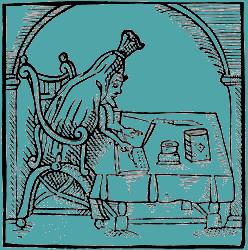“Yes trust them not: for there is an upstart Crow, beautified with our feathers, that with his Tygers hart wrapt in a Players hyde, supposes he is as welable to bumbast out a blanke verse as the best of you: and beeing an absolute Johannes factotum, is in his owne conceit the only Shake-scene in a countrey.”
Greene, Robert, A Greenes Groats-worth of Wit, 1592.

Robert Greene would probably not be very happy to know that of everything he ever wrote these are the lines of his most quoted. In addition, he would probably have been apoplectic to imagine that for four hundred years they would be completely misunderstood.
Tradition holds that this excerpt is a specific reference to Shakespeare (ie: “Shake-scene”) and that Greene was warning his fellow poets, in particular Marlowe, Nashe and Peele (Who had been working with him on what was to become Henry VI Parts I, II and III) to be wary of this interloper from Stratford.
Stratfordian scholarship is so hungry for any historical reference that might tie back to Shakespeare that they furiously grasp at this statement. The trouble is that Greene wasn’t talking about Shakespeare. He never met Shakespeare, whoever he was. He as talking about Ned Alleyn.
Edward Alleyn. Remember him? Brother of the man who William Bradley owed 14 Pounds and who attacked Christopher Marlowe in Hog Lane only to be killed by Marlowe’s friend, Tom Watson? Ned Alleyn, the most important actor on the London stage in 1592? The man who played the lead role in Greene’s Orlando Furioso (which bombed – it was and is bad) and who had succeeded extraordinarily in Marlowe’s Tamburlaine, Faustus and The Jew of Malta, not to mention in Kyd’s Spanish Tragedy.
When Greene talked about a “Shake-scene” type of actor, he was talking about someone who indulged in bombast, someone who in modern terms chewed the scenery, while making the further pun on bumbast, which is stitching, which is to say that this person imagines that because he can shout out a playwright’s lines he therefore imagines that he can compose better lines. And the person he was pointing to was Alleyn.
Following the death of Gabriel Spencer at the hands of Ben Jonson and the breakup of Pembroke’s Men, of which Alleyn had been a leading member and actor, he joined forces with Phillip Henslowe, manager of Lord Strange’s Men, which later became The Admiral’s Men, chief competitor to the Lord Chamberlain’s Men which later became the King’s Men, the company which produced most of the plays credited to Shakespeare.
Alleyn married Joan Woodward, step-daughter of Philip Henslowe, in October 1592, prior to which Henslowe had paid him handsomely for performances in April and May in the same year of a play titled Tamar Cham, Parts 1 and 2. As the former lead actor of Marlowe’s Tamburlaine, it does not seem like a stretch to suppose that the “Shake-scene” accused of “bumbasting out a blanke verse” was simply rewriting his most successful role for his new business partner.
Unfortunately, this play has been lost; only a plot outline remains, upon which many scholars have noted the similarity with Tamburlaine. More importantly, Ben Jonson, who clearly saw it in performance, commented in his Timber: or, Discoveries that “the Tamerlanes, and Tamer-Chams of the late Age, . . . had nothing in them but the scenical strutting, and furious vociferation, to warrant them to the ignorant gapers” (H&S 8.587).
So Henslowe and Jonson both confirm Greene’s accusation against Alleyn that he was taking the “feathers” of authors like Marlowe, Nashe and Peele to stitch together his own inventions. Shakespeare, whose sole acting credit is from a play produced five years later, is nowhere in sight.
![Title page of 1592 publication of Greene's Groatsworth of Wit, [Public domain], via Wikimedia Commons](https://islandshakespearefestival.wordpress.com/wp-content/uploads/2016/07/groats.jpg?w=656)
The whole “Shake-scene” thing has another level of importance. Robert Greene is almost universally cited as the inspiration for the character of Falstaff. However, if Greene was referring to Ned Alleyn and not Shakespeare then the connection fails outright. If Greene never knew Shakespeare, which seems likely, then there could be no reason for Shakespeare to take him as inspiration for what Harold Bloom considers one of his three greatest characters.
On the other hand, Marlowe knew Greene intimately and Greene’s relationship to Marlowe, if Greene’s report of it is to be trusted, was very much like the relationship portrayed in Henry IV I & II between Falstaff and Prince Hal.
Robert Greene died in 1592 at the age of 34, reportedly of drink and dissipation, shortly before the publication of A Groatsworth. Alleyn, meanwhile, lived to the age of sixty and became so wealthy that he was able to found the College of God’s Gift at Dulwich which exists to this day.
Next: Will Kempe
 Dr. Peter Hodges holds a BFA in Acting from the University of Washington (class of ‘75), an M.A. in Directing and a Ph. D. in Literature from The City Graduate Center of The City University of New York City, New York (1986 and 1992). Dr. Pete (as he is sometimes known among his friends) is a 30 year veteran of the Wall Street wars, author and producer of more than a dozen plays, a novel, and a critical study of Sadakichi Hartmann’s plays.
Dr. Peter Hodges holds a BFA in Acting from the University of Washington (class of ‘75), an M.A. in Directing and a Ph. D. in Literature from The City Graduate Center of The City University of New York City, New York (1986 and 1992). Dr. Pete (as he is sometimes known among his friends) is a 30 year veteran of the Wall Street wars, author and producer of more than a dozen plays, a novel, and a critical study of Sadakichi Hartmann’s plays.


One thought on “The Passionate Pilgrim 1.12: A Little Bit More About Ned Alleyn”